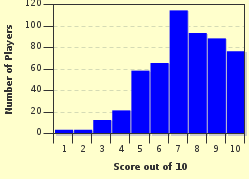Quiz Answer Key and Fun Facts
1. He enjoyed opera just as much as a snack of freshly cooked human brains, and didn't need a psychiatrist to tell him what was going on; after all, he was one. Which serial killer was sophisticated as well as callous?
2. He was the nemesis of one of our greatest literary sleuths. They locked horns many times until, fatefully, they fell together from the top of a waterfall. Which villain was part of a plot that outraged readers and prompted one of the greatest returns from the dead in literature?
3. He was an Old-Etonian with a cruel streak - even if he was literally handicapped. Although he had a gentle side, which villain was usually in a rage with a boy who refused to grow up?
4. Robber, child abuser, murderer of a good-hearted prostitute, and who knows what would have happened if he had got hold of that poor orphan. No matter how you twist it, which inhabitant of old London Town was a total bounder?
5. She was the housekeeper from hell who nearly drove her master's new wife to suicide, but the story ended up happily when she got her comeuppance. Which female fiend had a fiery finale?
6. Characters didn't need to be mad to have appeared in this quiz, but if they were mad, well... they would still have appeared. Which military villain accepted payments from the enemy to bomb his base - and sold the morphine from the medical kits to line his own pockets?
7. He was chubby, well-dressed and charming - he was Italian after all - and with a harmless hobby, yet which villain was the brains behind a plot to deprive a rich young woman of her wealth and sanity? Twitchers everywhere were never looked at in the same light again.
8. His boss thought him "honest, honest" but he was set on destroying his master's world for his own reasons. Some have been baffled by his 'motiveless malignity', but behind his smiles and jokes, which villain was pure evil?
9. She was a bare-footed beauty in Bohemian Paris, he was the master who could hypnotise her to sing wonderfully. Which villain had a name that has become part of the English language to describe people of a great influence?
10. Which villain was a mysterious foreign financier who was welcomed by the toffs of London's society, until they discovered he had been swindling them?
Source: Author
darksplash
This quiz was reviewed by FunTrivia editor
Bruyere before going online.
Any errors found in FunTrivia content are routinely corrected through our feedback system.


